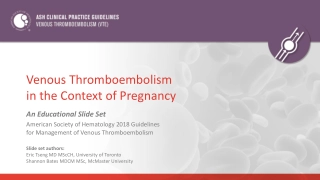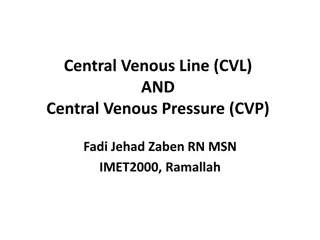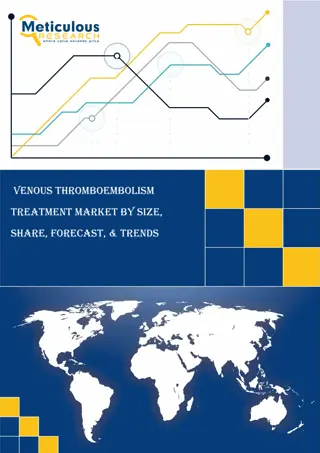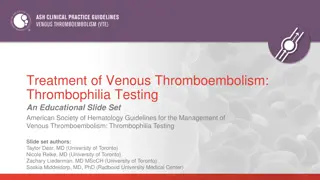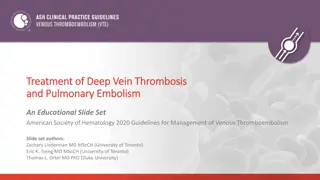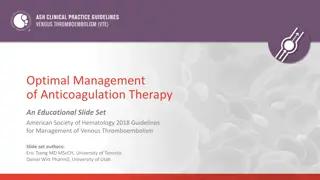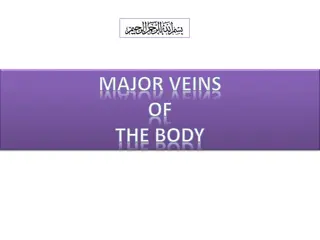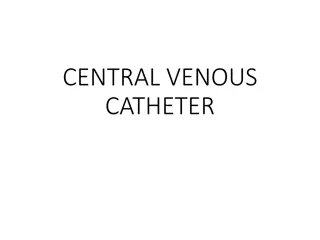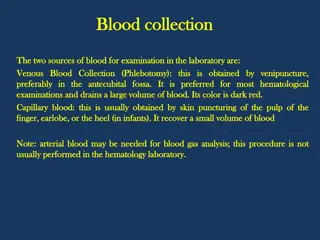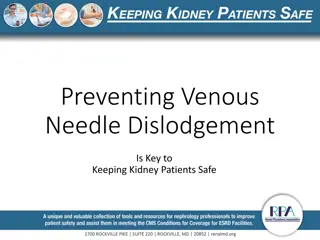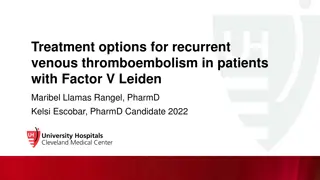Venous Thromboembolism Diagnosis and Management in Latin America: ASH 2022 Educational Slide Sets
The American Society of Hematology (ASH) 2022 guidelines for the diagnosis and management of venous thromboembolism in special populations in Latin America are presented in educational slide sets authored by Dr. Juan Carlos Serrano Casas and other experts. The Latin American ADOLOPMENT project, a collaborative effort involving various hematology societies, aims to provide evidence-based recommendations through the GRADE-ADOLOPMENT framework.
Download Presentation

Please find below an Image/Link to download the presentation.
The content on the website is provided AS IS for your information and personal use only. It may not be sold, licensed, or shared on other websites without obtaining consent from the author.If you encounter any issues during the download, it is possible that the publisher has removed the file from their server.
You are allowed to download the files provided on this website for personal or commercial use, subject to the condition that they are used lawfully. All files are the property of their respective owners.
The content on the website is provided AS IS for your information and personal use only. It may not be sold, licensed, or shared on other websites without obtaining consent from the author.
E N D
Presentation Transcript
Internal use Venous Thromboembolism Diagnosis and Management of Venous Thromboembolism Diagnosis and Management of Special Populations in Latin America Special Populations in Latin America Educational Slide Sets American Society of Hematology 2022 for the Management of Venous Thromboembolism Disease Author: Dr Juan Carlos Serrano Casas, MD, Central University of Venezuela Cl nica Cancerol gica de Norte de Santander (North Santander Oncology Clinic)
Internal use Clinical Practice Guidelines ASH, ABHH, ACHO, CAHT Group, CLAHT Group, SAH, SBHH, SHU, SOCHIHEM, SOMETH, Panamenian Society of Hematology, SPH, SVH. 2022 guidelines for venous thromboembolism diagnosis and management of Special Populations in Latin America Ignacio Neumann, Ariel Izcovich, Ricardo Aguilar, Guillermo Le n Basantes, Patricia Casais, Cecilia Colorio, Cecilia Guillermo, Pedro Garcia Lazaro, Jaime Pereira, Luis Meillon, Suely Meireles Rezende, Juan Carlos Serrano, Mario Luis Tejerina Valle, Felipe Vera, Lorena Karzulovic, Gabriel Rada, Holger Schunemann.
Internal use Latin American ADOLOPMENT project The Latin American ADOLOPMENT project is a pilot collaborative effort of the following institutions Argentinian Society of Hematology (Sociedad Argentina de Hematolog a, SAH), Cecilia Colorio, MD Bolivian Society of Hematology and Hemotherapy (Sociedad Boliviana de Hematolog a y Hemoterapia, SBHH), Mario Luis Tejerina Valle, MD Brazilian Association of Hematology, Hemotherapy and Cellular Therapy (Associa o Brasileira de Hematologia, Hemoterapia e Terapia Celular, ABHH), Suely Meireles Rezende, MD PhD Chilean Society of Hematology (Sociedad Chilena de Hematolog a), Jaime Pereira, MD Peruvian Society of Hematology (Sociedad Peruana de Hematolog a, SPH), Pedro Garc a L zaro, MD Uruguay s Society of Hematology (Sociedad de Hematolog a del Uruguay, SHU), Cecilia Guillermo, MD Venezuelan Society of Hematology (Sociedad Venezolana de Hematolog a, SVH), Juan Carlos Serrano, MD Latin American Cooperative for Hemostasis and Thrombosis (Grupo Cooperativo Latinoamericano de Hemostasis y Trombosis, CLAHT), Patricia Casais, MD Mexican Association of Hematology (Asociaci n Mexicana de Hematolog a), Luis Meillon, MD Colombian Association of Hematology and Oncology (Asociaci n Colombiana de Hematolog a y Oncolog a), Guillermo Basantes, MD American Society of Hematology MacGRADE Center GRADE-ADOLOPMENT is an explicit and systematic method for adoption, adaptation, or development of evidence- based recommendations derived from the existing GRADE-focused recommendation. GRADE Evidence to Decision frameworks for adoption, adaptation, and de novo development of trustworthy recommendations: GRADE-ADOLOPMENT (J Clin Epidemiol. 2017 Jan; 81:101-110).
Internal use ASH Clinical Practice Guidelines on VTE 1. VTE prevention in surgical hospitalized patients 2. VTE prevention in VTE prevention in medical hospitalized patients 3. Acute VTE treatment (DVT and PE) 4. Optimal management of anticoagulation therapy 5. VTE prevention and treatment in cancer patients 6. Heparin-Induced Thrombocytopenia (HIT) 7. Thrombophilia 8. VTE diagnosis 9. Pediatric VTE 10. VTE in the context of pregnancysurgical hospitalized patients
Internal use How were the ASH guidelines were developed? PANEL FORMATION Each panel was formed following these key criteria: Balance of expertise (including disciplines beyond hematology, and patients) Attention to minimization and management of COI CLINICAL QUESTIONS 10 to 20 clinically-relevant questions generated in PICO format (population, intervention, comparison, and outcome) EVIDENCE SYNTHESIS Evidence analysis for each PICO question x systematic review of effects: Desirable and undesirable effects Resource use Feasibility Acceptability Accessibility Patient values and preferences MAKING RECOMMENDATIONS Recommendations made by panel members based on evidence for all factors PICO QUESTION EXAMPLE In a population of patients with low clinical probability of PTE, what is the best diagnostic strategy to assess a PTE hypothesis? ASH guidelines are reviewed annually by expert work groups convened by ASH. Resources, such as this slide set, derived from guidelines that require updating are removed from the ASH website.
Internal use How should patients and clinicians use these guidelines? STRONG Recommendation ( The panel recommends ) CONDITIONAL Recommendation ( The panel suggests ) Most individuals would want the intervention. Most individuals would want the intervention, but many would not. For patients Different choices will be appropriate for different patients, depending on their values and preferences. Use shared decision making. Most individuals should receive the intervention. For clinicians
Internal use OBJECTIVES: To provide evidence-based guidelines on the diagnosis of VTE/PE and the treatment of VTE in children and during pregnancy. METHODS The GRADE ADOLOPMENT SYSTEM has allowed the adaptation of 3 ASH guidelines on VTE (Diagnosis, Pregnancy, and Pediatric chapters.) 12 local hematology societies formed a panel of guidelines made up of medical professionals from 10 Latin American countries. We have prioritized 10 questions about VTE diagnosis and 18 about management for special populations relevant in a Latin American context. Evidence analysis, benefits, and damages; also, to be considered are values and preferences, resources, accessibility, feasibility, impact, and equity in health.
Internal use DIAGNOSTIC CONSIDERATIONS Prevalence and Probability Pretest The diagnosis of venous thromboembolism (VTE) is based on an assessment of the clinical probability of VTE in a population before diagnostic tests (pretest probability, PTP) Patients are identified as low/intermediate/high probability or likely/unlikely to have VTE Low PTP (unlikely) = low VTE prevalence (Intermediate)/high PTP (likely) = high VTE prevalence VTE prevalence in a population influences the predictive value of diagnostic tests
Internal use RESULTS OF THE LATIN AMERICAN GUIDELINES ANALYSIS Compared to the original guidelines, Significant changes have been made to 2/10 diagnostic recommendations And to 9/18 management recommendations (4 guidance changes and 5 strength changes).
Internal use Pretest PE probability based on clinical prediction rules Revised Geneva score Wells score for PE Component Score Component Score Prevalence per PTP: High PTP: 50% Intermediate PTP: ~20% Low PTP: 5% Pain on deep palpation Previous DVT or PE Unilateral lower limb pain Tachycardia Active malignant condition Recent surgery or fracture Hemoptysis Age 65 4 3 3 DVT Signs / Symptoms No alternate diagnosis Tachycardia Immobilization / Surgery Previous DVT or PE Hemoptysis Active malignant condition 3 3 1.5 1.5 1.5 1 1 0 / 3 / 5 2 2 2 1 Score 11: High PTP: Score 4 to 10: Intermediate PTP Score 0 to 3: Low PTP Score > 6: High PTP: Score 2 and 6: Intermediate PTP Score < 2: Low PTP Wells Ann Intern Med 1998 Le Gal Ann Intern Med 2006
Internal use Clinical prediction rules (PPT) for DVT: Wells score for lower limb DVT Geneva score for PE Component Score Component Score Age 65+ Previous PTE or DVT Surgery or fracture within 1 month Malignancy Unilateral lower limb pain Hemoptysis Heart rate 75 to 94 per min Heart rate 95 or more per min Pain on deep palpation of lower limb and unilateral edema 1 3 2 2 3 2 3 5 4 Active malignant condition Localized sensitivity Whole leg swollen Calf swelling > 3 cm Insect bite edema Collateral superficial veins Previous DVT Bedridden/surgery Paralysis Alternate diagnosis 1 1 1 1 1 1 1 1 1 -2 Low probability 8% (score 0 to 3) Intermediate probability 28% (score 4 to 10) High probability 74% (score 11) Score 3: highPTP ( 50% prevalence) Score: 1 to 2: Intermediate PTP (~25%) Score: 0 or less: low PTP ( 10%) Wells NEJM 2003 Le Gal G, Ann Intern Med 2006 Kleinjan Ann Intern Med 2014
Internal use DIAGNOSTIC TEST ACCURACY Studies that assess diagnostic tests (CTPA, D-Dimer, etc.) compared to the reference standard Pretest Probability (VTE prevalence in a group) VTE Post- TestProbability Test Accuracy
Internal use Case 1: SUSPECTED PULMONARY EMBOLISM 64-year-old male History: HBP, ischemic heart disease Medication: Losartan, Carvedilol, Atorvastatin, Aspirin. Arrives at E.R. with: chest pain, dyspnea, palpitations No data suggesting VTE, no cancer, QX, surgeries Recent mild bronchopneumonia in outpatient care Examination: Heart rate of 93 per min, 90% saturation in ambient air, grade I/IV edema in lower limbs Chest X-ray: Cardiomegaly Clinical pretest probability (revised Geneva score)low 3 pts
Internal use Your patient s pretest probability for PE is low or intermediate. Which of the following tests would you recommend to exclude PE diagnosis? A. Pulmonary angiotachy B. High-sensitivity d-dimer C. Bilateral leg compression ultrasound D. Electrocardiogram E. Chest X-ray
Internal use Recommendation 1 and 2 For patients with low pretest probability of a first episode or recurring PE ( 5%), the Latin American ASH guidelines panel recommends the use of D- dimer to exclude PE (strong evidence-based recommendation due to high certainty about the effects ), followed by a CT pulmonary angiogram (CTPA) in patients with positive D-dimer (conditional recommendation based on very low certainty about the effects The same diagnostic strategy is recommended for intermediate PTP patients (starting with D- dimer) ). Notes: If CTPA is not available, an alternative could be a VQ scan followed by a proximal compression ultrasound (CUS,) if the VQ scan fails to discard or confirm the PE (conditional). Recommendation based on very low certainty about the effects )
Internal use D-dimer diagnostic threshold D-dimer has limited use in the following patient groups, due to the high frequency of positive results with standard thresholds: Hospitalized Post-surgery Pregnant The use of "age-adjusted" D-dimer cutoff in 50+ outpatients is as safe as the standard cutoff and increases diagnostic usefulness Age-adjusted threshold = age (years) x 10 g/L (using d-dimer tests with a 500 g/L threshold) Righini JAMA 2014
Internal use Recommendations for Latin American Guidelines SCINTIGRAPHY LIMITATIONS A change has been made to the Original Guidelines: D-dimer was used, followed by VP scintigraphy (VPS) and CT angiography should it not be available. The purpose is to lower exposure to radiation. The Latin American panel considered that D-dimer was affordable and generally available in the region; therefore, it was considered a reasonable first step to rule out PE. There is very limited VPS availability in Latin America, therefore the choice to suggest a CT angiography instead of VP as a follow- up test in case of a positive D-dimer. Probability of a diagnostic result (normal or high probability) Less feasible in case of: older people, preexisting pulmonary disease, abnormal chest X-ray.
Internal use Imaging considerations for VQ and CTPA scans in case of suspected PE Limited institutional access or experience in Nuclear Medicine VQ Scan CTPA At risk of reaction to contrast media requiring premedication + - Concern about radiation issues in female breasts + - Renal insufficiency + - Suspected VTE recurrence or treatment failure with PE index diagnosed by VP scintigraphy + - Suspected VTE recurrence or treatment failure with PE index diagnosed by CTPA + +/- Concern about radiation affecting the fetus (especially in the first trimester) +/- +/- Minimizing undiscovered VTE risk at 3 months +/- +/- Requirement of timely result and both modalities accessible - + Actively sought alternative or concomitant diagnoses (such as cancer) - + Abnormalities present in plain radiography (hyperinflation, effusion) - + Limited institutional access or experience in Nuclear Medicine - +
Internal use Case continued Due to low PESI score, the patient was placed on anticoagulation with Rivaroxaban 15 mg every 12 hours on an outpatient basis for 21 days, then Rivaroxaban 20 mg per day for 3 to 6 months due to symptoms caused by previous bronchopneumonia; patient took only one more month and abandoned treatment because another physician told them to. After 15 days, the patient had chest pain again with dyspnea and also an increase in the volume of the right leg with pain. Recurrent PTE is suspected. What type of test would you recommend? A. Pulmonary angiotachy B. High-sensitivity d-dimer C. Bilateral leg compression ultrasound D. Electrocardiogram E. Chest X-ray
Internal use HIGH PROBABILITY OF RECURRENT PTE Recommendations 4 and 5 For patients with high pretest probability of a first episode or recurring PE ( 50%), the Latin American ASH guidelines panel recommends a strategy starting with CTPA (both conditional recommendations based on very low certainty about the effects ) Notes: If clinical suspicion of PTE remains high after a negative CTPA, a follow-up with compression ultrasound or D-dimer may help rule out the diagnosis. Conclusions: A pretest probability 50% indicates that PE is the most likely diagnosis. Under such circumstances, the D-dimer can no longer safety discard PE. Many of the region s cases may require transfer to a center where CT angiography is available. The crucial decision to be made is whether to start empirical anticoagulation or wait for test results. When deciding, consider CT angiography delay, risk of death from PTE, bleeding, patient values and preferences.
Internal use PTE diagnosis flowchart for patients with pretest probability of recurrent episode CDR = clinical decision rule (i.e., Wells or Geneva score) PE: pulmonary embolism, CDR: clinical decision rule CTPA: CT pulmonary angiogram, PTP: pretest probability * Dynamically stable hemo ** High-sensitivity D-dimer
Internal use Case 1: Summary In patients with low or intermediate PTP for PE, a negative high-sensitivity D-dimer may safely discard PE without the need for additional tests. Latin American Guidelines for CT Angiography on VP Scintigraphy, especially for older patients or those with pre-existing lung disease. Patients with suspected recurrent PE should be categorized between likely or unlikely PTP to determine further testing, despite the fact that clinical prediction rules have not been widely validated for recurrent PE.
Internal use VTE During Pregnancy Objectives When you finish this section, you should be able to: 1. Describe the recommendations for acute VTE management during pregnancy. 2. Identify pregnant patients who need VTE prophylaxis antepartum and/or postpartum
Internal use VTE is one of the main causes of morbidity and mortality during pregnancy VTE incidence is similar during antepartum and postpartum periods, but the postpartum period is shorter, thus increasing the daily risk of VTE Venous thrombosis causes complications in roughly 1.2 in every 1,000 births Such increased risk persists until 12 weeks postpartum, with higher risk during the first 6 weeks postpartum VTE diagnosis, prevention, and treatment during pregnancy must consider fetal and maternal well-being
Internal use Case 1: Deep vein thrombosis during pregnancy 28-year-old female patient, first pregnancy, 32 weeks, lives close to the city. Personal History:Deep vein thrombosis at age 22, while taking oral contraceptives. Medication:Vitamins, her doctor did not prescribe antithrombotic prophylaxis. Arrives at E.R.: With increased volume on the right leg over the past few days, chest pain and associated dyspnea. Fr 91 x mm, 91% sat. Lower limb venous echo doppler: Shows evidence of right femur DVT and analysis of the pulmonary CT angiography evidences bilateral subsegmental pulmonary embolism. Pesi score 28 pts very low risk
Internal use Patient is 29 weeks pregnant and low-risk acute proximal DVT with pulmonary embolism, hemodynamically stable. Where would you recommend this patient be treated? A. In hospital for at least 15 days B. In hospital for 48 hours and in outpatient care for the rest of the time C. Outpatient care for the entire period D. ICU admission B and C are Correct
Internal use Recommendation 15 For pregnant women with DVT or TPE, and low-risk pregnancies (maternal or fetal factors), the Latin American ASH Guidelines recommends home treatment instead of hospitals (conditional recommendation based on a low probability on the evidence over the effects ) CONS PROS Evidence in pregnant women is limited (inconsistent data) Access to outpatient LMWH or FNH can be difficult in some countries Occasionally, pregnant women may feel safer in the hospital and prefer this option Patients value most the comfort of receiving home treatment This can lower health system costs Less functional and emotional impact CAUTION: Invalid option in high-risk cases: Abnormal vital signs, analgesic needs, extensive VTE, advanced maternal age, maternal comorbidities LMWH contraindications
Internal use Question 2 What anticoagulant would you suggest for his DVT? (UFH = Unfractionated heparin, LMWH = Low molecular weight heparin) A. Subcutaneous UFH B. Direct oral anticoagulant C. UFH 1 or 2x a day, with anti-Xa monitoring D. LMWH 1 or 2x a day, with anti-Xa monitoring
Internal use Which anticoagulant can be used safely during pregnancy? Acceptability in pregnancy Anticoagulant Comments Does not cross the placenta LMWH is preferred over UFH due to maternal security profile (less risk of TIH, reduced bone mineral density); Does not cross the placenta LMWH YES UFH YES Does not cross the placenta Has been reported to cross the placenta in small amounts Very limited clinical experience with fondaparinux Fondaparinux Not preferred Crosses the placenta Teratogenicity potential, pregnancy loss, fetal bleeding, neurodevelopmental disorders Vitamin K antagonists (VKAs) No Direct oral anticoagulants Probably dabigatran and Xa inhibitors cross the placenta Reproductive effects in humans are unknown. No
Internal use Recommendation 12 For pregnant women with acute VTE, the Latin American ASH panel suggests LMWH 1x or 2x a day, based on clinical circumstances and patients' values and preferences (conditional recommendation based on low certainty on the evidence about the effects ) Notes: LMWH 1x a day may lead to a higher maximum concentration and lower minimum level. The impact of pharmacokinetics in patients is uncertain. Women who value most avoiding injections may choose LMWH once a day. While women who value most possible complications from LMWH pharmacokinetics, may prefer LMWH 2x a day. LMWH doses prescribed 2x a day compared to 1x a day. Event Number of studies Impact of dose regimens 2 observational studies Low general incidence of VTE (<1 %), without difference between the dose regimens Recurrent PE 2 observational studies Low general incidence of VTE (<1 %), without difference between the dose regimens Recurrent DVT Major bleeding (antenatal or postpartum) 2 observational studies Low general incidence of a major bleeding (<1 %), without difference between the dose regimens Quality of Evidence (GRADE): Low Moderate Strong
Internal use Case 2 continued: Decision about Thromboprophylaxis 28-year-old woman with first pregnancy of 32 weeks with DVT and PE, and low risk, treated during entire pregnancy and puerperium with LMWH 1x a day; Gave birth to a healthy child in excellent conditions. Medical evaluation after 3 months Complete thrombophilia profile study: It is possible to determine protein S levels in repeated 15% antigenic method Their relatives were studied Mother: with protein level S: 12% Younger sister with S protein: 10%
Internal use The relatives were confirmed with Deficiency of S protein, the younger sister is 12 weeks pregnant, having developed obesity before the pregnancy, and lives far away from the city center; do you want to know the plan for thromboprophylaxis in your case? What is recommended to prevent VTE associated to pregnancy during the first pregnancy of the sister? A. Anticoagulant prophylaxis is not recommended in antepartum, but in postpartum B. Lower extremity duplex ultrasound examinations and treatment only if recurrent DVT is diagnosed C. Only antepartum anticoagulant prophylaxis D. Antepartum anticoagulant prophylaxis is not recommended postpartum E. Antepartum and postpartum anticoagulant prophylaxis are recommended
Internal use Recommendation 22 For pregnant women with inherited thrombophilia, the ASH guideline panel suggests against administering anticoagulant prophylaxis (conditional recommendation based on the low certainty about the evidence of the effects ). Notes: Women with high-risk thrombophilia: family history of thrombosis, homozygous factor V Leiden mutation, PT G20210A, combined thrombophilia (double heterozygous), and AT III deficiency, may be at increased risk of VTE during pregnancy. The benefits of prophylaxis may outweigh the risk of bleeding. Women at low risk: No family history or heterozygous for factor V Leiden or PT G20210A mutation. The risk of bleeding outweighs the benefits. Between these two groups, there is an intermediate risk of thrombosis. Therefore, doctors and patients can analyze additional risk factors to decide. The original panel pointed out 3 factors: 1. Recommendation against antepartum prophylaxis in women with low-risk thrombophilia 2. Recommendation against prophylaxis in women with high-risk thrombophilia 3. Recommends prophylaxis in women with thrombophilia and previous VTE events. The Latin American Panel recommended the same for low-risk and high-risk women with thrombophilia, but they were combined into a single recommendation statement.
Internal use Recommendation 22 For pregnant women with inherited thrombophilia, the ASH Guidelines for Latin American panel suggests postpartum anticoagulant prophylaxis over no prophylaxis (conditional recommendation based on very low-certainty evidence on the effects ). Notes: Probably the risk of thrombosis increases in postpartum compared to prepartum. Therefore, most women with a family history of thrombosis and thrombophilia can benefit from prophylaxis. In women heterozygous for factor V Leiden or the PT G20210A mutation, with no family history of VTE, the risk of thrombosis may be low enough to be safely treated without prophylaxis. Clinicians and patients may consider additional risk factors for DVT to decide.
Internal use Recommendation 22 For pregnant women with inherited thrombophilia, the ASH Guidelines for Latin American panel suggests postpartum anticoagulant prophylaxis over no prophylaxis (conditional recommendation based on very low-certainty evidence on the effects ). This recommendation partially changed its guidance and strength THE ORIGINAL PANEL RAISED: - Two conditional recommendations in favor of postpartum prophylaxis in women with a family history of VTE + protein C or S deficiency, in addition to cases with combined thrombophilia and homozygotes for factor V Leiden or prothrombin G20210A - A strong recommendation for postpartum prophylaxis in women with a family history of VTE, and antithrombin II deficiency - Two recommendations against postpartum prophylaxis in women without a family history of VTE, heterozygous for factor V Leiden or prothrombin G20210A mutation, or with AT III, Protein C or S deficiency, and in women with a family history of VTE who are heterozygous for factor V Leiden or PTG20210A. THE LATIN AMERICAN PANEL HAS A DIFFERENT APPROACH - Due to the increased risk of thrombosis during the postpartum period, most women may be better off with prophylaxis. - A single recommendation was issued suggesting this course of action, while contextualizing different clinical scenarios on the comments.
Internal use Recommendation 22 For women with no VTE personal history, the panel recommends: Family history of VTE Antepartum prophylaxis Postpartum prophylaxis Inherited thrombophilia patient No formal recommendation** (+) Yes Homozygous PGM (-) No Yes (+) Yes Yes Homozygous factor V Leiden (-) No Yes (+) Yes Yes Combined thrombophilia (-) No Yes **There are no formal recommendation as there are no family studies on homozygous PGM available. However, panel members are in favor of an antepartum prophylaxis considering the VTE risk estimates. Quality of evidence (GRADE): Low Moderate Strong
Internal use Recommendation For women with no VTE personal history, the panel recommends: Family history of VTE Antepartum prophylaxis Postpartum prophylaxis Inherited thrombophilia patient These recommendations were based on a VTE risk threshold of 2% antepartum and 1% postpartum to recommend LMWH prophylaxis Heterozygous PGM o Heterozygous Factor V Leiden (+) No No (-) No No (+) No Yes Protein S Deficiency o Protein C Deficiency Our patient: Protein S deficiency with family history (+). The patient s estimated VTE risk is 1.8% postpartum but increases with additional risk factors (obesity). (-) No No (+) Yes Yes Antithrombin Deficiency (-) No No Quality of Evidence (GRADE): Low Moderate Strong
Internal use The patient receives a daily prophylactic dose of LMWH. She is 32 weeks pregnant, and her estimated due date is in 7 weeks. She would rather have a vaginal delivery with epidural anesthesia. What do you suggest for managing her prophylaxis around the time of delivery? A. Change anticoagulation to intravenous heparin, then elective (induced) delivery with interruption of IV heparin 6 hours prior to delivery B. Planned (induced) labor with interruption of LMWH 24 hours prior to delivery C. Allow spontaneous labor before discontinuing LMWH anticoagulation D. Elective cesarean section with suspension of LMWH 48 hours prior to delivery E. Maintain LMWH now as it requires anticoagulation
Internal use Recommendation For pregnant women taking prophylactic LMWH doses, the Latin American ASH panel suggests the elective delivery with prior suspension of LMWH over LMWH interruption with the spontaneous onset of labor (conditional recommendation based on low evidence of the effects ). Notes: Although most women receiving prophylactic doses of LMWH may have a safe spontaneous labor, many women in Latin American have limited access to a qualified delivery care. In this scenario, a scheduled induction in a hospital may be safer for women taking LMWH. In this scenario, a scheduled induction in a hospital may be safer for women taking LMWH. A scheduled induction may facilitate neuraxial anesthesia and reduce maternal bleeding risk (very low certainty of evidence)
Internal use Summary: Back to the objectives of VTE in pregnant women 1. Describe the recommendations for acute VTE management during pregnancy. Place of care, anticoagulation scheme, planning in childbirth 2. Identify pregnant patients who need prophylaxis antepartum and/or postpartum: Classification of inherited thrombophilia risk, use of thromboprophylaxis in patients with and without a DVT history, use of prophylaxis before delivery in high-risk thrombophilias and postpartum in most thrombophilias.
Internal use TREATMENT OF PEDIATRIC VENOUS THROMBOEMBOLISM Objectives At the end of this section, you will be able to: 1. Describe the recommendations for treating asymptomatic VTE in children. 2. Manage children with PTE and hemodynamic failure.
Internal use Pediatric VTE is a disease primarily of hospitalized children VTE in the general pediatric population is rare (0.07 to 0.14 per 10,000 children) The VTE rate in children increases from 100 to 1000 times in hospitalized children The presence of a central venous catheter (90 % of all VTE) and other children (more than 60 %) There are no anticoagulants approved for use in children, and very little specific research on pediatric VTE.
Internal use Case 3: Asymptomatic DVT. 6-year-old boy Patient is taken to surgery to correct intestinal stenosis. Due to the need for a central venous catheter placement was performed. The postoperative evolution was excellent, free of infection or bleeding. , The catheter was removed after 8 days without problems. Before discharge, the pediatrician noted that there was a mitral murmur not heard before and an echocardiogram was done. A slight mitral stenosis was observed, as well as an internal jugular vein thrombosis without cardiac involvement that was asymptomatic
Internal use You have diagnosed your patient with an asymptomatic non-occlusive DVT in the internal jugular vein and superior vena cava, which was probably caused by a removed central venous catheter. What treatment would you suggest for this patient's asymptomatic DVT? A. Therapeutic anticoagulation B. No anticoagulation, as it was an incidental finding C. Without anticoagulation, repeat ultrasound in 1 week to ensure it has not extended D. Graduated compression stockings E. Intermittent pneumatic compression devices
Internal use Recommendation 23 For children with asymptomatic VTE, the Latin American ASH guidelines panel suggests against anticoagulation (conditional recommendation based on the very low certainty of evidence over the effects ). Comments For most children with asymptomatic VTE, the risk of anticoagulation probably outweighs the benefits. Some patients at high risk of thrombosis recurrence or those who may require multiple central venous access devices during their lifetime may benefit from anticoagulation. The final decision must consider individual risk factors, as well as parent and child values and preferences. This recommendation changed guidance. The original ASH panel made a conditional recommendation of anticoagulation or no anticoagulation. The Latin American panel considered that in most children with asymptomatic VTE the risk of bleeding exceeds potential benefits.
Internal use Case 4 6-year-old female preschool patient diagnosed with stage IIB diffuse large cell non-Hogdkin lymphoma and a large mediastinal mass. After biopsy surgery, presents dyspnea, with severe low blood pressure, requiring medical management with vasopressors. Her chest CT angiography revealed large thrombi in the pulmonary arteries, with severe right ventricular dysfunction on echocardiography. Idx: Massive pulmonary thromboembolism with hemodynamic compromise
Internal use The girl has a massive pulmonary embolism with hemodynamic compromise. What do you recommend in this case? A. No anticoagulation, since the risk of bleeding is high. B. Anticoagulation therapy with low molecular weight heparin C. Catheter-directed thrombolysis (CDT) followed by anticoagulation D. Surgical thrombectomy followed by anticoagulation E. Prophylactic IVC filter placement F. Prescribe Rivaroxaban in anticoagulant dose.
Internal use Recommendation 24 For children with PE and hemodynamic failure, ASH Latin American recommends thrombolytic therapy in addition to anticoagulation (strong recommendation based on low-certainty evidence on effects ). Comments There is uncertainty regarding the effect of thrombolytics in children due to the lack of studies with the adequate statistical power and design. The available evidence in adults suggests a positive effect of thrombolytics in preserving life in a condition of high mortality. This scenario justifies a strong recommendation in favor of intervention following the ASH GRADE rules. This recommendation changed its strength. The original panel made a conditional recommendation in favor of thrombolytic therapy. The Latin American panel considered the changes in baseline mortality risk identified in the update (22% vs. 4.5%) and issued a strong recommendation.
Internal use Pulmonary embolism with hemodynamic failure is a serious condition associated with high mortality New evidence. In an additional study (n=5654), overall mortality in children with PE was 8.6%, with a bimodal distribution with a first peak in children under 1 year of age and a second peak in adolescents aged 16-17 years. The first peak in young children was largely explained by congenital conditions such as underlying heart diseases. The second study identified (n=170), showed a similar overall mortality of 6%, but also independently reported a mortality risk of 22% in children with PE and hemodynamic failure. van Ommen CH, Heijboer H, B ller HR, Hirasing RA, Heijmans HS, Peters M. Venousthromboembolism in childhood: a prospective two-year registry in The Netherlands. J Pediat Nov 2001;139(5):676-81. Andrew M, David M, Adams M, et al. Venous thromboembolic complications (VTE) in children: first analyses of the Canadian Registry of VTE. Blood. Mar 1 1994;83(5):1251-7.
Internal use FINAL CONSIDERATIONS Although there are no direct data from randomized trials conducted in children, indirect evidence from the adult population suggests a potential life- preserving benefit. Given the high mortality observed in children with PE and hemodynamic failure, thrombolytic therapy should be routinely offered. Implementation of this recommendation may be hampered by a lack of appropriate facilities and human resources to deliver critical care in some settings within the regions. Efforts must be made to ensure timely access to specialized care for children with PE and hemodynamic failure.




